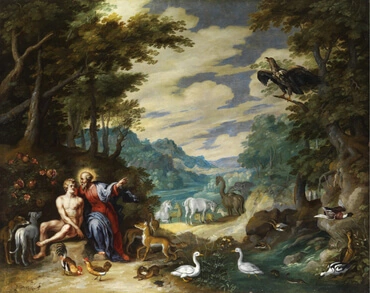1
Således fuldendtes Himmelen og Jorden med al deres Hær.
2
På den syvende Dag fuldendte Gud det Værk, han havde udført, og han hvilede på den syvende Dag efter det Værk, han havde udført;
3
og Gud velsignede den syvende Dag og helligede den, thi på den hvilede han efter hele sit Værk, det, Gud havde skabt og udført.
4
Det er Himmelens og Jordens Skabelseshistorie. Da Gud HE
EN gjorde Jord og Himmel
5
dengang fandtes endnu ingen af Markens Buske på Jorden, og endnu var ingen af Markens Urter spiret frem, thi Gud HE
EN havde ikke ladet det regne på Jorden, og der var ingen Mennesker til at dyrke Agerjorden,
6
men en Tåge vældede op at Jorden og vandede hele Agerjordens Flade
7
da dannede Gud HE
EN Mennesket af Agerjordens Muld og blæste Livsånde i hans Næsebor, så at Mennesket blev et levende Væsen.
8
Derpå plantede Gud HE
EN en Have i Eden ude mod Øst, og dem satte han Mennesket, som han havde dannet;
9
Og Gud HE
EN lod af Agerjorden fremvokse alle Slags Træer, en Fryd at skue og gode til Føde, desuden Livets Træ, der stod midt i Haven. og Træet til Kundskab om godt og ondt.
10
Der udsprang en Flod i Eden til at vande Haven, og udenfor delte den sig i fire Hovedstrømme.
11
Den ene hedder Pisjon; den løber omkring Landet Havila, hvor der findes Guld
12
og Guldet i det Land er godt, Bdellium og Sjohamsten.
13
Den anden Flod hedder Gihon; den løber omkring Landet Kusj.
14
Den tredje Flod hedder Hiddekel; den løber østen om Assyrien. Den fjerde Flod er Frat.
15
Derpå tog Gud HE
EN Adam og satte ham i Edens Have til at dyrke og vogte den.
16
Men Gud HE
EN bød Adam: "Af alle Træer i Haven har du Lov at spise,
17
kun af Træet til Kundskab om godt og ondt må du ikke spise; den Dag du spiser deraf, skal du visselig dø!"
18
Derpå sagde Gud HE
EN: "Det er ikke godt for Mennesket at være ene; jeg vil gøre ham en Medhjælp, som passer til ham!"
19
Og Gud HE
EN dannede af Agerjorden alle Markens Dyr og Himmelens Fugle og førte dem hen til Adam for at se, hvad han vilde kalde dem; thi hvad Adam kaldte de forskellige levende Væsener, det skulde være deres Navn.
20
Adam gav da alt Kvæget, alle Himmelens Fugle og alle Markens Dyr Navne - men til sig selv fandt Adam ingen Medhjælp, der passede til ham.
21
Så lod Gud HE
EN Dvale falde over Adam, og da han var sovet ind, tog han et af hans
ibben og lukkede med Kød i dets Sted;
22
og af
ibbenet, som Gud HE
EN havde taget af Adam, byggede han en Kvinde og førte hende hen til Adam.
23
Da sagde Adam: "Denne Gang er det Ben af mine Ben og Kød af mit Kød; hun skal kaldes Kvinde, thi af Manden er hun taget!"
24
Derfor forlader en Mand sin Fader og Moder og holder sig til sin Hustru, og de to bliver eet Kød.
25
Og de var begge nøgne, både Adam og hans Hustru, men de bluedes ikke.







